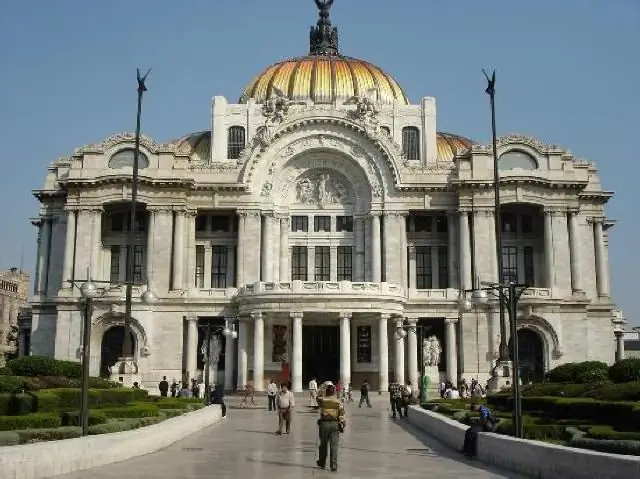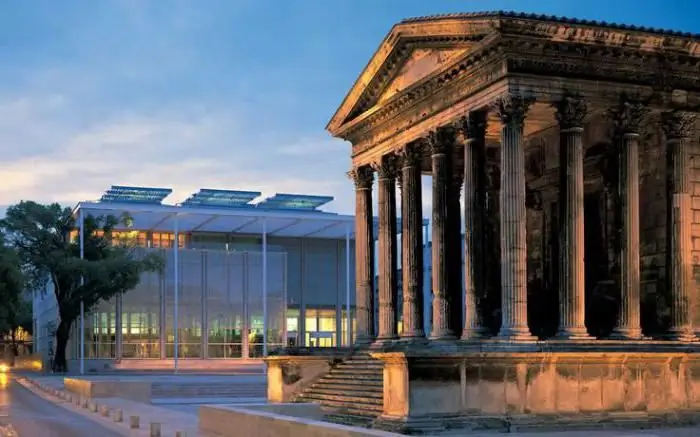- Author Harold Hamphrey [email protected].
- Public 2023-12-17 10:06.
- Last modified 2025-01-24 11:10.
The pre-Columbian pyramids of Teotihuacan are located northeast of modern Mexico City, 50 km from it, and rise above the surrounding valley. This pyramid complex is all that remains of the once largest city in Central America, located in a country like Mexico. You can see his location on the map below.

Traces of an ancient civilization
Tourists coming here are inspired by the amazing technological power of the ancient civilization that created the city. Teotihuacan consisted of a thousand residential complexes, as well as several pyramid temples, which can be compared with the largest Egyptian pyramids. The ancient city was built and subsequently abandoned. This happened long before the arrival of the Aztecs in central Mexico. The Aztecs, amazed by what they saw, called this city Teotihuacan, which means "divine place". They believed that the gods created the universe here. This archaeological complex is today the most visited in Mexico. Numerous tourists rush here to see the UNESCO World Heritage Site with their own eyes.
Where can you see the pyramids?
The word "pyramid" for most people is associated with Egyptian ancient monuments. In fact, ancient cultures on almost every continent built triangular monuments at some point in history. Important relics of a mysterious lost culture are the pyramids located in the city of Teotihuacan. The largest of them is the Pyramid of the Sun. In Mexico, you will not find anywhere else buildings of this era of such scale and grandeur.
Some facts from the history of Teotihuacan
Approximately in the 1st c. BC. began the development of Teotihuacan. The most active phase of construction and expansion took place before 450 AD. This important economic and religious center of pre-Columbian America was inhabited by approximately 125 thousand inhabitants (200 thousand, according to some estimates). At its peak, it covered an area of 23 sq. km and was the largest city in the world at that time.
Teotihuacan gained political and economic weight largely due to the obsidian trade. This stone has played a significant role in the history of mankind. During this period, the Indians who inhabited pre-Columbian America did not know how to smelt iron. They made weapons, tools, jewelry from obsidian.
Teotihuacan, oddly enough, in the presence of large pyramids did not have any defensive structures at all. Scholars, however, argue that its cultural and military influence extended to many regions of Central Asia. America.
Mysteries of Teotihuacan

The origin of this ancient city is still a mystery. It raises many questions: where did the local inhabitants come from, what language did they speak, why did they leave this place around 700? Various hypotheses have been put forward by archaeologists about the reasons for the death of this civilization, ranging from its enslavement by warlike neighbors to the depletion of various resources necessary for this civilization to survive. From the once huge city, 3 large and several small pyramids, some houses of the nobility, sacrificial altars have survived today.
Monumental painting of Teotihuacan
Ancient builders decorated their monuments with paintings and covered with plaster. The Teotihuacan pyramids themselves have stood the test of time, but not their stucco and painting. It is believed that the paintings made on the sides of the monuments included images of snakes, stars, and jaguars. It should be noted the highest level of craftsmanship achieved by the monumental painting of Teotihuacan in Central America.
Mystic city energy
Teotihuacan after the decline turned into a place where noble Aztecs came for pilgrimage. It continues to be an important pilgrimage center today: thousands of believers come here every year to celebrate the day of the vernal equinox here, and also to plunge into the mystical energy radiating from the ruins of Teotihuacan. At the pyramids, you can spend a whole day wandering among these works of architecture. The pyramids are a window into the world of ancient Mexico. Let's talk more aboutsome of them.
Pyramid of the Sun

In Central America and Mexico, it is customary to build new temples on the remains of previous ones. Therefore, the Pyramid of the Sun was built on the remains of ancient buildings until it reached its current size. Most likely, the construction was completed in the 1st century. AD, and 300 years later they built a temple on top. It was completely destroyed by the time the Spaniards discovered Teotihuacan, and the pyramid, covered with trees and shrubs, turned into a mass of rubble.
The Pyramid of the Sun is the third largest ancient structure in the world after the Pyramid of Cholula in Mexico and the Pyramids of Giza in Egypt. The perimeter of its base is 893 meters. This is almost the same as the pyramid of Cheops. But with its height (71 m), this structure is half as low as its counterpart in Egypt. The pyramid was built from 3 million tons of stone. It did not use wheels, pack animals and metal tools. Despite the fact that it was not built as a tomb for the ruler, artificially dug tunnels were found at a depth of 6 m from its surface. Their archaeologists consider the builders of Teotihuacan spiritually significant. This pyramid played an important role in religious and political life.
Huge crowds of tourists during the spring equinox visit Teotihuacan. They climb the steps of this pyramid and with open arms turn to face the Sun. There are many interpretations of this tradition, but most participants believe that at this moment the divine energy that is in it is released. Many visitors say that they feel at this moment a sense of peace and harmony with the world.
Pyramid of the Moon

In the northern part of Teotihuacan is the second largest ancient pyramid. It is built on a small hill. In height, it looks almost the same as the Pyramid of the Sun, but in fact it is 29 m lower. The same beautiful panorama opens from its top, as well as from the top of its neighbor. During excavations carried out at the foot of the structure, the remains of animals sacrificed, as well as tombs with stone artifacts, were discovered. Visitors can climb the Pyramid of the Moon and enjoy views of the city along the "Avenue of the Dead" from here.
Citadel, Temple of the Feathered Serpent
The square, which was called the Citadel by the Spaniards, is located in the center of Teotihuacan. Here, it is believed, were the houses of the elite and the residence of the supreme ruler of this city. The huge square was not really a fortress, although the imposing walls, each of which was 390 m long, created the appearance of a defensive structure. The Temple of the Feathered Serpent is the central element of the Citadel. It was built in the form of a pyramid, which was once decorated with intricate carvings in the form of feathered snake heads, partially preserved on the western side. This temple is also known for the numerous burials of sacrificed animals that were found within its walls.
Useful tips for tourists

Pyramid of the Sun (it is located likewe found out, in Teotihuacan) is the third largest such structure in the world. However, this is the highest pyramid in the world, on top of which you can climb. In order to do this, it is necessary to overcome 248 steps. And now you are already standing on the spot where the main priests of the ancient Aztec civilization climbed, and under your feet is the ancient Pyramid of the Sun in Teotihuacan. A beautiful panoramic view of the city opens from its top. And the Pyramid of the Moon is a place from which you can admire the "Avenue of the Dead". This alley divides the ancient city into two parts. It got its name from the Aztecs, who took the small temples on both sides of the avenue for the tombs of the kings. Scholars have now determined that these were temple-topped ceremonial platforms.

An extensive place is occupied by an archaeological complex, here you will have to walk quite a lot, climb the ancient pyramids. Therefore, you should take care of water, sandwiches, a hat, sunscreen and good sports shoes.
First climb the pyramids, and only then walk around the entire complex. If you decide to visit it early in the morning, take beautiful photos from its top; and crowds of other visitors going down and going up will not bother you.
Teotihuacan is unfortunately very commercialized today. Try to come here on weekdays and early to avoid a large flow of tourists and enjoy the ancient pyramids to the fullest. Groups of visitors with localssalesmen show up here later.

Local merchants in the complex are constantly approaching tourists, trying to sell them various trinkets, which is sometimes annoying. It will be unusual for you if you have never been to Mexico before. Sometimes these people can be very persistent and aggressive. Just don't look them in the eye, or tell them "No, gracias" and they'll leave you behind. The vendors mainly sell silverware, which is cheap in Mexico, as well as Aztec flutes.
In Teotihuacan, local vendors offer snacks and drinks. However, many tourists take sandwiches with them. Almost any restaurant or hotel in Mexico City can prepare a dry breakfast for you.
The ruins of Teotihuacan (Mexico) are open daily from 7 am to 5 pm. On the map, which can be bought in the Mexico City area, you will find other local attractions. Entrance to the territory of the complex is paid. An additional fee is also charged for the use of the video camera.
If you have a car, you can drive freely around the perimeter, provided that you are heading to one of the local restaurants or staying at a hotel here. Otherwise, the police may forbid it.






